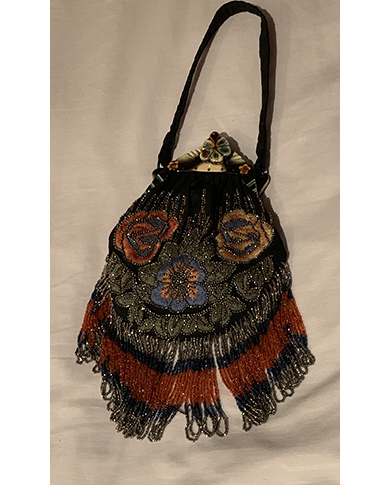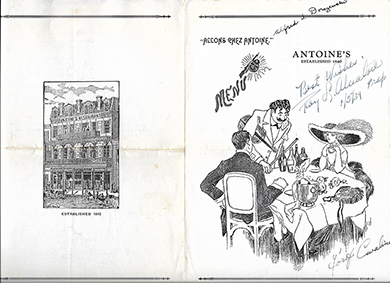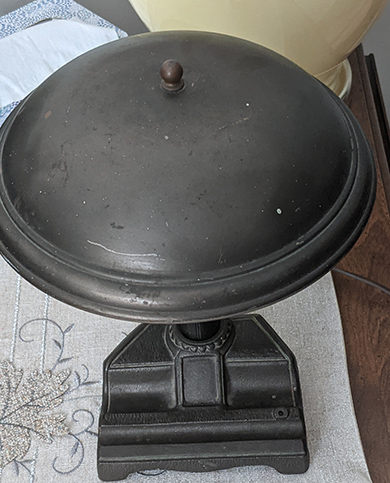 |
|
|||
 |
 |
|||
RINKER ON COLLECTIBLES — Column #1779 Copyright © Harry Rinker, LLC 2020 Questions
and Answers
QUESTION: I inherited a beaded purse that belonged to my great grandmother. The family story is that my great grandmother beaded a baptismal gown for Princess Beatrice. My great grandmother was born in 1871 and lived 100 years. I have searched all the Queen and Princess Beatrice births that I could find. None match the time when my great grandmother could have beaded and sewed the baptismal gowns. Princess Beatrice of the United Kingdom, the fifth daughter and youngest child of Queen Victoria and Prince Albert was born on April 14, 1857 and died on October 26, 1944. She does not fit. Can you help me? I also have in my possession an envelope full of pieces of stained glass from the Reim’s Cathedral in France. My grandfather was sitting below the window when a bomb went off. He was showered with bits of the stain glass window. He grabbed a handful and brought them home. What should I do with them? – DdeV, Eugene, OR, Email Question 
ANSWER: You need to begin by doing your family genealogy. Where was your great grandmother born? Assuming she immigrated to the United States, where did she live prior to coming to the United States? If your great grandmother was born in the United States, discount the family story. The possibility of it being true is negligible. Princess Beatrice did not marry until July 23, 1885. She had four children – Alexander Mountbatten (born November 23, 1886), Victoria Eugènie (born October 23, 1887), Lord Leopold Mountbatten (born May 21, 1889), and Prince Maurice of Battenberg (born October 3, 1891). Realizing what follows is most likely false, perhaps your great grandmother beaded and sewed the baptismal gown for one of Princess Beatrice’s children. In order to even consider this, you need to prove your great grandmother was living in England at the time and had connections with the Royal family. There are times I feel “Rinker on Collectibles” readers feel I have a closet filled with black hats because of the number of times I deliver bad rather than good news when answering questions. From the beginning, I have adopted a “call it like I see it” approach. In your case, my advice is to discount the family story, obviously distorted over time, and move on. Proving that your great grandmother actually beaded the beaded purse in your possession also will be difficult. The picture of the beaded bag that accompanied your email indicates the beading is of high quality. Given this, this is not a once and done project. Few individuals who created beaded purses included a marking in the beadwork that identified a maker. If you know of no other beaded purses attributed to your great grandmother, then my advice remains the same. Discount the family story and move on. As a beaded purse, your purse has a secondary retail market value between $250.00 and $300.00. The secondary market for beaded purses has fallen in the past 10 years. I am certain the Reims Cathedral would love you to donate the envelope filled with glass fragments. Again, you need to provide a strong provenance to back up your grandfather’s story. A quick search indicated the Germans bombed the Reims Cathedral on September 4, 1914, shortly before the Germans captured the city. After the French recaptured the city, bombing resumed. Was your grandfather French and did he serve in the French army? If yes to both questions, was his unit in Reims at the time of the bombing? It makes no sense to assume a member of an American armed forces unit would have been in the cathedral during the bombing. When researching antiques and collectibles, one question often leads to many others. Until they are all answered, it is impossible to determine a plausible answer to the initial question asked. If your research does reveal a strong provenance, contact the Reims Cathedral and ask if they have any interest in the glass shards. If yes, donate the entire envelope to it. QUESTION: In sorting through my father-in-law’s “stuff,” I found a signed menu from Antoine’s in New Orleans. It is hand signed “Best Wishes, / Roy L. Alciatore, Prop. / 1/5/34.” The menu most likely was acquired by my father-in-law’s parents or a sister. The menu includes “Huitres en coquille á la Rockefeller (our creation) .60” and “Pompano en Paillotte .90.” Filet Mignon was $1.75. The menu begins with the headline “$1.00 PER PERSON MINIMUM.” – SD Lansdale, PA, Email Question 
ANSWER: Antoine Alciatore founded Antoine’s, perhaps New Orleans’ most famous family-owned restaurant, in 1840. He ran it until his death in 1875. His widow Julie Freyss Alciatore managed the restaurant from 1875 to 1887 so that their son Jules Alciatore could complete his culinary training in France. When Jules returned to New Orleans in 1887, he assumed control of the restaurant. Jules acquired additional property adjacent to the restaurant site as it came on the market, building Antoine’s into a restaurant with 15 dining rooms that could accommodate 800 people. Roy L. Alciatore, Jules’ son, took over in 1934 and managed the restaurant until 1972. There is every reason to believe the signature on the menu is authentic. It is noteworthy because it was done during the first year of Roy’s management. I had the privilege of dining at Antoine’s several times during visits to New Orleans. I had Oysters Rockefeller every time. I love eating dishes in the restaurants that created them. I do not remember if I had “Pompano en papillote” but made a mental note to order it when I next visit New Orleans, hopefully in early October 2021 at the conclusion of a Mississippi River steamboat cruise. Researching the secondary market value for Antoine’s restaurant menus on WorthPoint.com, I was surprised by how little interest there was in them. An unsigned menu identical to the one you owned sold between $10.00 and $15.00. Roy L. Alciatore’s signature adds another $5.00 to $10.00. More desirable by a few dollars is the Antoine’s 1940 Centennial Menu. The next time you visit New Orleans, take the menu with you, make a reservation at Antoine’s, and ask if they will exchange the menu for a free meal or at very least a free order of Oysters Rockefeller. QUESTION: I have an electric desk lamp that is over 100 years old. It is marked on the bottom: “JOS SHOEMAKER / PHIL PA USA.” The metal lamp has a raised dome shade. The stepped down base has a location for supplies and a pen or pencil. Any information you can give me would be appreciated. – RS, Belmont, MI, E-mail Question 
ANSWER: I found an advertisement for Joseph L. Shoemaker & Co., located at 925 Arch Street, in Philadelphia, on the internet. The advertisement featured an elaborate office desk and a note that the company sold bank, dining-room, library, and office furniture. There was no date attributed to the advertisement. In 1875, the Atlantic Snuff Company was located in a commercial loft at 924 Arch Street, located on the edge of Chinatown. The information noted: “Other turn-of-the-Century tenants included the office furniture showroom of Joseph L. Shoemaker & Co. and two German language newspapers….” Your lamp’s appearance suggests a 1920s or early 1930 date of origin. I did find a “Fictitious Names” company Joseph L. Shoemaker & Company registered on March 11, 1918. The company was located at 217 West Washington Square in Philadelphia. WorthPoint.com has several listings that exactly match the lamp you own. Sell through listings, primarily from eBay, over the last four years suggest a secondary market retail value between $75.00 and $100.00. Descriptions range from “Industrial Edwardian Art Deco” to “1939 San Francisco World’s Fair Lamp.” The 1939 example has the fair information in relief on the base. This version sells for double the above prices. QUESTION: have a full set of American Winfield China Desert Dawn dinnerware. I want to sell it. What advice do you have? – JC, Email Question ANSWER: The good news is that there is modest buyer interest in the pattern. The bad news is that there is modest interest in the pattern. Pieces sell on eBay. However, there is a big difference between asking price and selling price. A reasonable realistic approach is to expect to get half of the asking prices. The key question is how much time do you want to spend disposing of the pieces? My recommendation is to try to sell the whole pile as opposed to trying to piece it out. Most buyers are looking to replace broken pieces from an inherited set or for serving pieces they do not own such as covered casseroles or platters. If you allow these pieces to be “cherry picked,” you will be stuck with dinner plates and other common pieces of little value. One price takes it all is the best approach; and, one that guarantees you are rid of the collection in one fell swoop. Craigslist is the best approach. The lower the asking price, the quicker the collection will sell. If the collection is a service for eight with serving pieces, ask between $75.00 and $90.00. Take any offer over $50.00. It may take several listings before you find a buyer. Harry L. Rinker welcomes questions from readers about
collectibles, those mass-produced items from the twentieth and twenty-first centuries.
Selected letters will be answered in this column.
Harry cannot provide personal answers.
Photos and other material submitted cannot be
returned.
Send your questions to: Rinker on Collectibles, 5955 Mill
Point Court SE, Kentwood, MI 49512.
You also can e-mail your questions to
harrylrinker@aol.com.
Only e-mails containing a full name and mailing address
will be considered.
|
||||